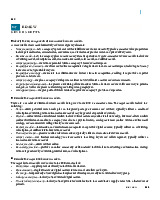





Preview text:
lOMoAR cPSD| 58583460 C a s e S t u d y 365 5.8 CASE STUDY
A l i p a y a n d W e C h a t P a y Lead in Mobile Payments
ith over 1.2 billion consumers worldwide expected to use a mobile wallet to
make a proximity mobile payment in 2021, it’s no surprise that a slew of
Wcompanies, including smartphone manufacturers and payment processing co
mpanies, are aggressively pursuing global
expansion for their mobile payment products. Traditional U.S. tech giants
like Google and Apple are aspiring to become the preferred mobile payment platform in as many
countries as possible worldwide; however, Chinese tech companies Alibaba and Tencent have a
commanding lead in this space, not Google and Apple.
China has over 58% of the world’s users of proximity mobile payments in 2021—a total of
over 680 million people and an increase of 10% from 2019. Proximity mobile payments are
those that take place at the point of sale, where the person paying for a good or service uses their
phone in tandem with NFC, QR codes, Bluetooth, or other, similar technology to make a
payment. Not every country has embraced proximity lOMoAR cPSD| 58583460 © Xinhua/Alamy Stock Photo 366
C H A P T E R 5 E - c o m m e r c e S e c u r i t y a n d P a y m e n t S y s t e m s
mobile payments, but China has proved to be the perfect environment for them to catch on. In
Western countries like the United States and Europe, credit cards are still in widespread use and
have been for many years, as are other payment systems tied to banks, such as debit cards and
checks. However, China has bypassed credit cards completely in favor of mobile payment apps.
There are only 0.31 credit cards per capita in China, compared to 2.5 credit cards per capita in the United States.
In 2019, the value of third-party mobile transactions in China totaled over 226 trillion yuan
renminbi. In contrast, in the United States, consumers only paid about $110 billion via
proximity mobile payments. In nearly every metric, China has outpaced the rest of the world in
mobile payments. In China, even street people accept handouts via QR codes; street musicians
carry pictures of QR codes to allow passersby to provide tips with Alipay or WeChat Pay. Only
now, with the Chinese mobile payments market nearly completely saturated, have other
countries like India begun to grow in mobile payment adoption at a faster rate; India had about
125 million mobile payment users in 2020, a distant second to China’s 650 million, but India
grew at a robust rate of almost 30% in 2020, with double-digit increases expected to continue
until 2023. Nevertheless, only about 38% of Indian smartphone users and 13% of the population
of India currently use mobile payments. Other countries in Asia-Pacific with heavy adoption of
mobile payments include South Korea (about 40% of smartphone users), Japan (about 32%),
Indonesia (about 23%), and Australia (about 20%). In many countries, the advent of biometric
authentication has been a major driver of mobile payment adoption, since it greatly reduces the
chances of identity theft and speeds up transaction speeds at the point of sale.
Despite China’s overwhelming adoption of proximity mobile payments, the country does
not have a thriving marketplace of many companies jockeying for dominance; just as in the lOMoAR cPSD| 58583460 C a s e S t u d y 367
United States, a small number of tech titans have cornered most of the market. Founded in 1999
by Jack Ma and Peng Lei, Alibaba is China’s largest e-commerce company, offering B2B e-
commerce on its flagship Alibaba website, C2C e-commerce on its Taobao marketplace, and
B2C e-commerce on its Tmall site (see the Chapter 12 opening case for more information on
Alibaba). In 2004, Alibaba created Alipay in response to widespread lack of trust between
buyers and sellers on its platforms. In 2011, Ma transferred Alipay out of Alibaba’s direct
ownership into Ant Financial, a financial services holding company that Ma controlled, but
Alibaba continues to have a significant interest in Alipay.
Alipay is an escrow-based system, where funds moving from one party to another are held
by Alipay until both sides of the transaction give their full approval. The system helped Alibaba
gain the trust of Chinese consumers, and when smartphone adoption began to skyrocket in 2008,
Alipay’s share of China’s mobile payments market also skyrocketed. Between 2010 and 2020,
the number of mobile Internet users in China grew from about 265 million to over 835 million,
and the percentage of the population that are digital buyers grew from about 17% of the Chinese population to almost 65%.
In 2019, Alipay reached a milestone, with 1 billion active users worldwide, and by March
2020, it had reached 1.3 billion, with over 700 million using it on a monthly basis. Alipay has
begun to grow into other areas, including Pakistan, South Korea, Malaysia, Thailand, and
Singapore, since the Chinese market has edged closer to full saturation. Alipay has also worked
to ensure that Chinese citizens traveling abroad can use Alipay to pay for goods overseas. As
the company’s user base has grown, Alipay has greatly diversified its offerings beyond online
and mobile payment. Payments used to be Alipay’s only focus; now mobile payment is the
gateway to a much larger array of financial products, all of which are more profitable than the
original payments business. For example, Alipay’s Yu’e Bao money market fund is now easily
the largest such fund in the world; Alipay users can quickly and easily invest in the fund with
the same app they use to make payments at a restaurant or grocery store. Alipay also uses
algorithmic assessments to offer loans both to individuals and to businesses; its artificial
intelligencepowered risk engine has reduced Alipay’s fraud-loss rate dramatically. Alipay offers
three types of loans: its Ant Micro Loan, which is intended for small businesses; its JieBei loans,
for individual consumers with high credit scores, and its Huabei (or Ant Check Later) loan,
which allows users to buy items on credit without paying interest. In addition to reducing fraud,
Alibaba’s algorithmic approach also allows the company to process loan requests incredibly
fast. Alibaba uses transaction data to analyze how a business is doing and how competitive it is
in its market as well as the credit ratings of the companies it partners with. Alipay is also
working on projects involving blockchain technology, AI, security, the Internet of Things, and many more.
In China, Alipay has only one real competitor: WeChat Pay. Just as Alipay arose from
Alibaba and its lineup of e-commerce sites, WeChat Pay arose from the incredibly popular text
and voice messaging service WeChat, operated by tech titan Tencent Holdings. WeChat has over
1.2 billion users and more than 800 million people reportedly use WeChat Pay every month.
Like Alipay, payment is only a small portion of WeChat’s larger ecosystem of services. WeChat
offers social networking features that resemble Facebook’s News Feed, featuring a comment
system that is more tightly limited to close friends; WeChat can also be used to pay parking
tickets, call an ambulance, translate from Chinese to English, pay bills, book train and air
transportation, reserve hotel rooms, make charitable donations, and perform online banking with
the WeBank online bank—it can even be used as a makeshift dating service. The sheer number lOMoAR cPSD| 58583460
of features offered by the WeChat app has made it central to Chinese consumers’ lives and has
increased the likelihood that they will use the app to make mobile payments.
WeChat stores money that can be used to pay for goods and services or to send to others;
in addition, WeChat also offers an extremely popular “red packet” feature, based on a long-
standing Chinese tradition practiced on the Chinese New Year and other significant occasions.
Using this feature, users can divide a predetermined amount of money into small virtual
“packets” called hongbao and send them to a group chat, allowing members of the group to race
to claim each packet. The red packet feature, which subsequently was also adopted by Alipay,
has been a significant driver in the popularity of mobile person-to-person (P2P) transactions,
with over 600 million people in China (54% of the population) sending or receiving money via a mobile payment app in 2020.
WeChat has made significant inroads against Alipay’s dominance in the Chinese market.
One technique it has used to achieve this is partnerships with other prominent Chinese services,
such as Chinese rideshare service Didi Chuxing, with whom WeChat Pay has an exclusive
partnership. WeChat has a similar arrangement with the Meituan Waimai on-demand food
delivery service, which no longer accepts Alipay due to its partnership with WeChat. Walmart’s
Chinese outlets also do not accept Alipay for these 368
C H A P T E R 5 E - c o m m e r c e S e c u r i t y a n d P a y m e n t S y s t e m s
19, 2019; “Global Mobile Payment Users 2019,” by Jasmine Enberg, eMarketer, Inc., October 24, 2019; “China Mobile Payment Users
2019,” by Man-Chung Cheung, eMarketer, Inc., October 24, 2019; “The $41.5 Trillion Shopping Bill of China’s Smartphone Users, “ by
SOURCES: “China Plans Tougher
Pooja Singh, Entrepreneur.com, March 29, 2019; “Alipay Hits 1 Antitrust Rules for Non-Bank
Billion Global Users,” by Charlotte
Payments Industry,” Reuters.com,
reasons. WeChat has also sought partnerships with foreign businesses, such as Japan’s Line
January 20, 2021; “5 Digital
messaging service; WeChat partnered with Line Pay in 2018 to make it easier for Chinese
Trends in China,” by Man-Chung
tourists in Japan to make mobile payments. WeChat has grown rapidly worldwide; in 2020,
Cheung, eMarketer, Inc., January
6, 2021; “Almost 600 Million
WeChat Pay could be used in 64 countries and regions. People in China Will Send or
To that end, WeChat has developed a cross-border payment system in partnership with
Receive Money via a Mobile App This Year,” by Ethan Cramer-
payment firm Travelex to allow Chinese tourists to shop overseas. Chinese customers of U.S. Flood, eMarketer,
retailers can use Travelex Pay to purchase goods; the money in their WeChat Pay accounts is
Inc., November 19, 2020; “The
used to generate a digital gift card in U.S. dollars, which is then immediately spent to purchase
Race to Be China’s Top Fintech
Platform: Ant vs Tencent,” by Rita
the desired items. Already, many of the biggest U.S. retailers that are popular with Chinese
Liao, Techcrunch.com, November
tourists are participating in the plan. The appeal is that it helps tourists avoid having to carry a 9,
lot of cash, and Chinese credit cards can trigger large fees for foreign transactions, which this 2020; “Proximity Mobile Payment
method avoids. WeChat and Alipay have both stated that their international expansion is
Users Worldwide, 2020–2024,”
focused on allowing Chinese travelers abroad to use the same features they are used to in
“Proximity Mobile Payment Users
by Country,” both eMarketer, Inc.,
China, but industry analysts suspect that both companies have greater ambitions for the U.S.
August 2020; “WeChat Pay Now
market, which still lags far behind in mobile payment adoption compared to China.
Accessible in Turkey,” by He Wei,
Both WeChat and Alipay are also similar in the enormous trove of data they possess on
Chinadaily.com, July 27, 2020;
“Google and Walmart Establish
their users. Because Alibaba and WeChat are so central to Chinese consumers’ lives, both Dominance in India’s Mobile
companies know a great deal about what their users buy, who their friends are, what their credit Payments Market as WhatsApp
scores are, and much, much more. The Chinese government has seemingly completely Pay
Struggles to Launch,” by Manish
unfettered access to WeChat messages, even retrieving deleted messages when they deem it
Singh, Techcrunch.com, June 3,
necessary, and has also heavily invested in and supported Alibaba. Some analysts speculate
2020; “Hong Kong’s Octopus Card Now Supports Apple
that because privacy is simply not as significant a cultural value in China as it is in other Pay,” by Mike Peterson,
countries, WeChat and Alipay are in a better position to monetize their trove of user data than Appleinsider. com, June 1, other companies might be.
2020; “China’s Ant Financial
Has No Timetable for a Listing,
While Alipay and WeChat Pay have been big winners in China’s mobile payment
but Targets 2 Billion Users in a
marketplace over the last decade, American tech companies have been left to play catchup. Decade,” By Saheli Choudhury, Cnbc.com, November
Apple in particular has a small fraction of users using Apple Pay compared to both Alipay and lOMoAR cPSD| 58583460 C a s e S t u d y 369 WeChat Pay;
traction. For example, in India, there are three major players: Google Pay, Walmart-backed WeChat also
PhonePe, and Alibababacked Paytm. In June 2020, Google Pay had 75 million transacting functions
users and PhonePe had 60 million. Paytm, which previously had been the dominant player, similarly on the
has reportedly slipped into third place in terms of number of transacting users but remains in iPhone and
the lead in terms of reach with merchants. Just like WeChat and Alipay, Paytm allows users Android, making
to make payments and send money to other users as well as book travel arrangements. In the two operating
Malaysia, the popular ridesharing service Grab has continued to expand, opening its platform systems mostly
to third-party services to develop more functionality akin to WeChat as well as launching the indistinguishable
GrabPay mobile wallet and GrabFood food delivery service. Boost is another popular payment to Chinese
service in Malaysia. In Singapore, DBS PayLah and SingtelDASH are in widespread use, as smartphone users. is GrabPay. For that reason,
Another important battleground for mobile payment providers is Hong Kong, which is Chinese
unique in the region in its reliance on cash and credit cards. As a result, Western tech consumers often
companies are slightly more competitive with Alipay and WeChat in the region. On the other prefer the lower-
hand, Hong Kong citizens have widely adopted the Octopus stored value card, which is cost Android, at
accepted by convenience stores, restaurants, and public transit. Launched in 1997, there are Apple’s expense.
more than 35 million Octopus cards in circulation, and it is used by more than 99% of the Google has had its
population, handling 14 million transactions a day. Mobile payment companies seeking to own problems
expand into Hong Kong and tap into its lucrative consumer base will require at least as with China over
competitive an option as Octopus. the years, though,
Alipay and WeChat are well positioned going forward, with massive user bases in China, including
profitable business models thanks to their vibrant ecosystems of services, and the backing of philosophical
two of the biggest tech companies in the world in Alibaba and Tencent. If Alipay and WeChat objections to
Pay are unsuccessful in growing into a particular region, they could simply opt to go the route China’s content
of strategic acquisitions; Alipay and its parent Ant Financial have already begun doing this. censorship policy.
However, both companies face challenges in their attempts to expand into Western markets, It seems unlikely
where credit cards are already in widespread use and are trusted by consumers. Without a that Google Pay
sufficiently compelling reason, customers in Europe and the United States are unlikely to will make a dent in
ditch their credit cards and switch not just to Alipay or WeChat Pay, but even to U.S.-based China’s mobile
services like Apple Pay and Google Pay. payment
However, perhaps the biggest challenge both companies face originates from the Chinese marketplace
government. In July 2020, China’s central bank, the People’s Bank of China (PBOC) urged without the ability
China’s Anti-Monopoly Commission to open an antitrust investigation into both Alipay and to create a similar
WeChat Pay, alleging that they had used their dominant market position to squash ecosystem of
competition. In January 2021, the PBOC announced drafts of tough new antitrust regulation products and
that would allow the PBOC to break up a non-bank institution such as Ant Financial or services to the
Tencent if the institution severely hinders the healthy development of the payment service ones that Alibaba
market. In addition, the PBOC has developed a national digital currency, Digital Currency and WeChat can
Electronic Payment (DCEP), which it asserts is necessary to combat the dominance of Alipay offer.
and WeChat Pay, and to bring broader access to proximity mobile payments to a greater Around the
percentage of the country’s population. Alipay and WeChat Pay are likely to find themselves world, other
in continuing contention with both DCEP and the PBOC in the coming years. payment systems are gaining lOMoAR cPSD| 58583460 Case share in China? Study
4. Why have countries like the United States been slow to adopt mobile Questions payment systems?
Yang, Caixinglobal.com, January 10, 2019; “Alipay Changes Name to Hanbao (But for Users, Nothing Will Change),” by Manya Koetse, 1. Why Whatsonweibo.com, January 8, has
2019; “A Closer Look: Apple’s
Troubles in China Grow as WeChat Underlines iPhone’s Appeal,” by Cam MacMurchy, 9to5mac. com, January 3, 2019; “Alipay vs China
Wechat Pay: Mobile Payment Giants Driving China’s Cashless Transformation,” by Ashley Galina Dudarenok, Asiaspeakers. org, January
2, 2019; “Mobile Payments in China Are Growing So Fast, Predictions Can’t Keep Up,” by Matthew Keegan, Jingdaily. com, November been
8, 2018; “China Leads Asia-Pacific for Mobile an
Payment Adoption,” by Danielle
Long, Thedrum.com, October 28, 2018; “What the Largest ideal Global Fintech Can Teach Us environ
About What’s Next in Financial
Services,” Cbinsights.com, October ment
4, 2018; “Digital Payment Firms to
Fight for Hong Kong Market,” Channelnewsasia.com, August suppor
16, 2018; “Future of Cashless t
Payments in Singapore,” by Quah
Mei Lee, Frost.com, June 8, 2018; mobile
“One Photo Shows That China Is Already in a Cashless Future,” by Harrison Jacobs, Businessinsider. com, May 29, 2018; “Why China’s payme Payment Apps Give U.S.
Bankers Nightmares,” by Jennifer nt
Surane and Christopher Cannon, system Bloomberg. com, May 23, 2018;
“Chinese Government Admits Collection of Deleted WeChat s?
Messages,” by Devin Coldewey,
Techcrunch.com, April 30, 2018; “Google Steps Up Global Fight for Digital Wallet as China Dominates Mobile Payments,” by Zen Soo 2. How
and Alice Shen, Scmp. com, February 21, 2018. has Alipay change d from its original iteratio n? 3. How has WeCha t grown to rival Alipay in mobile payme nt market



